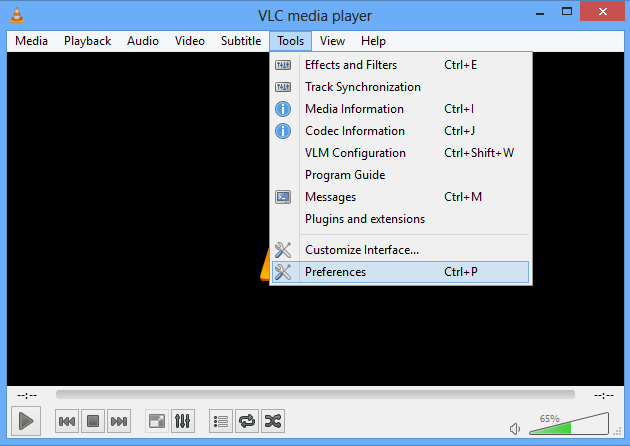
| This page describes how to make VLC the default media player. | Other 'how to' pages |
VideoLAN, VLC, VLC media player and x264 are trademarks internationally registered by the VideoLAN non-profit organization. VideoLAN software is licensed under various open-source licenses: use and distribution are defined by each software license. Design by Made By Argon. Some icons are licensed under the CC BY-SA 3.0+. Graphical Interface Many people who want to use VLC media playeron macOS will be intending to use the standard graphical interface that is provided by VLC. The standard interface consists of the eight menus in the menu bar and the 'VLC - Controller' window that opens up by default.
- 1Windows
- 3Linux
- 3.1Fedora
- 3.1.1GNOME
- 3.1Fedora
Windows
- See also: How to associate media files with VLC.
Vlc Player Download
XP
The simplest way to set VLC as the default media player for Windows is during installation of VLC. During set-up, VLC will ask you if you want to associate certain media file types (such as .mp3, .flv, .wav) with VLC; for each 'association' chosen opening that file type will launch it in VLC. By default, all are selected, though you might (or might not) want to un-check file types you'd like to open with another programme.
If you've missed this chance at making it the default media player during set-up, perhaps the easiest way is to un-install it and then install it again.
A word of caution regarding re-installation—be sure to un-check the box that deletes your preferences and cache, or all your customisations will be gone!
Vista, 7, 8
Open VLC player, click on Tools in the menu, and from there select Preferences.

Click on the Interface button on the left panel and then click on Set up associations... (it's close to the bottom).
Select types of files from the list that appears. Check any file types for which you want VLC to be the default player, or just check the select all option.
Mac
Right-click on the type of file you want to always open with VLC. Click 'Get Info'. In the 'Open With' section, select VLC from the drop-down menu. To apply this change to all files of this type, click the 'Change All' button.
For optical media, like CDs or DVDs, go to Apple -> System Preferences and choose 'CDs/DVDs' in the Hardware section. Choose 'Other Application' from the respective popup menu button. The list is alphabetical, so VLC should be near the bottom of the list.
Linux
Fedora
GNOME
Gnome uses two lists (located at /usr/share/applications/) – mimeinfo.cache and defaults.list – to register applications to file types.
You can either edit these manually or use the tools that GNOME has for this.
Download Free Vlc Player For Mac
Instructions on how to do it in GNOME
Changing the default application for videos using menus (the easy way):
Using Nautilus 2.30.1, from the top menu bar choose 'Places', then Home Folder -> Edit menu -> Preferences -> choose Media tab -> and in the drop-down list next to 'DVD Video' choose 'Open VLC media player'.
Voilà.
Alternatively, try: System -> Preferences -> Personal -> Preferred Applications -> Multimedia -> Custom -> Type this: vlc %U
(P.S.: this alternative hasn't been tested yet).
Changing the default application for videos using menus (the not-so-easy way):
|
|
|
Changing the default application for videos manually (the hard way):
In Fedora 10 the path /usr/share/applications/ will take you to these 2 files that configure what application opens a type of file.
defaults.list
mimeinfo.cache
P.S.: Both files will point to a Desktop Entry file ([name of the file].desktop) that is inside the applications folder, and the 2 important things inside that file are the configurations for what MIME Types the application can handle, and how to launch the application.
A Desktop Entry file is a data file that provides information about an item in a menu.The desktop entry specification describes desktop entries as files describing information about an application such as the name, MIME Types it handles, icon, and description. These files are used for application launchers and for creating menus of applications that can be launched.
If you don't have the VLC Desktop Entry file, or it disappears for some reason you will have to make one. Look here for some pointers.
You only need to modify mimeinfo.cache, I hope. It works for me. If it doesn't work for you, please edit this!
So what you have to do is:
- Open mimeinfo.cache as root.
- Search for the MIME Types for video.
- Change all of them to use VLC.
For example:
Registry of MIME Type (video/quicktime) in mimeinfo.cache to use VLC.
video/quicktime=livna-vlc.desktop;totem.desktop;miro.desktop;
The format is:
[MIME Type]=[Name of the Desktop Entry file]
Note: You can put more than one Desktop Entry, but they need to be separated by a semi-colon (;), see the example above.
Those extra entries will appear as options when you right-click on the video file and go to the Open With submenu.
Tip: Nautilus don't show the real names of the Desktop Entry files. Either drag and drop it on gedit so you see the name on the tab, or use ls to list the files on the command line.
References
- Registering Applications for MIME Types (Editing defaults.list and mimeinfo.cache)
KDE
[TODO]

VLC 3 running on Linux and GNOME Shell, playing Spring, a short film by the Blender Foundation | |
| Developer(s) | VideoLAN |
|---|---|
| Initial release | February 1, 2001; 19 years ago[1] |
| Repository | |
| Written in | Core: C GUI: C++ (with Qt), Objective-C (with Cocoa), Swift, Java Bundled Extensions: Lua[2] |
| Operating system | Windows, Windows Phone, macOS, Linux, Android, Chrome OS, iOS, iPadOS, Apple TV, Tizen, watchOS, Xbox One |
| Platform | IA-32, x86-64, ARM, ARM64, MIPS, PowerPC |
| Available in | 48 languages[3] |
| Type | Media player |
| License | GPL-2.0 with some libraries under LGPL-2.1[4][5] |
| Website | videolan.org/vlc |
VLC media player (also known as VLC or VideoLAN Client) is a free softwaremedia player by the VideoLAN project.
It is a highly portable multimedia player, encoder, and streamer that supports many kinds of audio and video. VLC can repair and play corrupt files, damaged or unfinished.
It is one of the most platform-independent players, available for BeOS, BSD, Linux, Mac OS X, Microsoft Windows, Solaris and Windows CE, and has over 50 million downloads for version 0.8.6.
VLC uses a large number of free decoding and encoding libraries. Many of its codecs are provided by the libavcodec codec library from the FFmpeg project, but it uses mainly its own muxer and demuxers. VLC gained honor as the first player to support playback of encrypted DVDs on Linux by using the libdvdcss DVD library.
History[change | change source]
VLC was initially the client for the VideoLAN project, and it was originally made by students at the École Centrale de Paris, and was released under the GPL license on the 1 February2001. It now has supporters and contributors worldwide.
The icon of VLC is a traffic cones collected by Ecole Centrale's Networking Students' Association.
Vlc Player Mac Download
Design principles[change | change source]
VLC has a very flexible design, which makes it easier to include modules for new file formats, codecs or streaming methods. There are more than 300 modules in VLC. VLC also supports highly personalizable skins through the skins2 interface, Winamp 2 and XMMS skins and can play high definition recordings of D-VHS tapes duplicated to a computer using CapDVHS.exe
Related pages[change | change source]
Other websites[change | change source]
- ↑'15 years of VLC and VideoLAN'. Jean-Baptiste Kempf. Retrieved April 15, 2017.
- ↑https://addons.videolan.org/p/1154045/
- ↑'VideoLAN internationalization'. VideoLAN. Retrieved April 15, 2017.
- ↑'VLC engine relicensed to LGPL'. VideoLAN. December 21, 2011. Retrieved April 15, 2017.
- ↑'VLC reaches 2.1.2'. VideoLAN. December 10, 2013. Retrieved April 15, 2017.
- ↑'VLC media player, Index of /testing/'. Retrieved February 9, 2018.